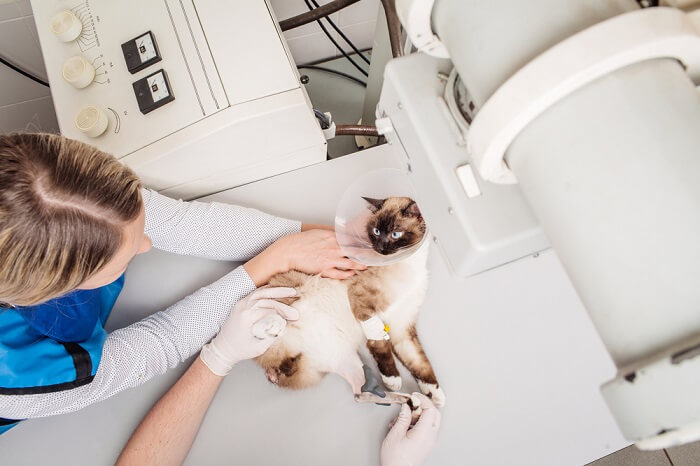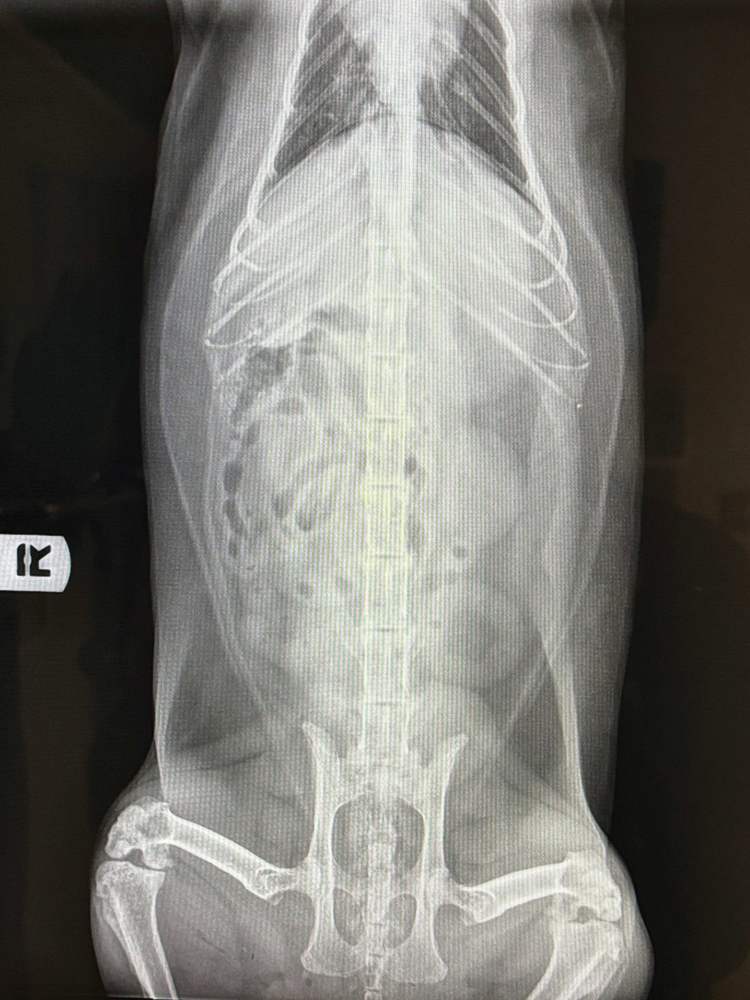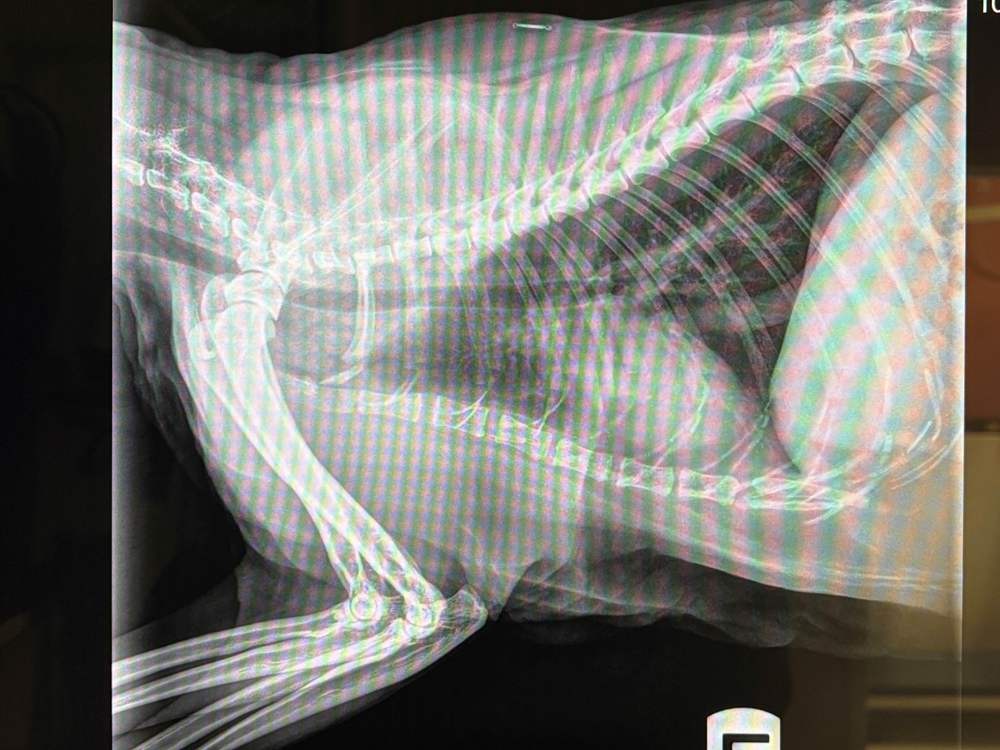
PRESSLAB / Shutterstock.com
If you’re a cat owner seeking information about cat X-rays, you’re probably wondering about the associated cost and procedure. Let’s explore the pricing and process of getting X-rays for your cat.
The cost of a series of x-rays is highly variable, depending on your region, but you can expect to pay $100-300 for a series of 2-3 x-rays. Emergency clinics may charge up to $400. If sedation or anesthesia is required for the x-rays, this will be an additional fee.
What Is a Cat Radiograph?

Bart Lateral Abdomen view: a clear radiographic look at abdominal organs, key for diagnosing internal issues. Chris Vanderhoof / Cats.com
A cat radiograph is a two-dimensional picture of a three-dimensional object. By taking two or more views, we get a more complete picture. The most common views are a lateral view, which is the kitty laying on one side, and a ventrodorsal view (VD), with the kitty laying on his back. Together, these images give us a more complete picture of what is going on inside.
In the days when x-rays were taken on film, most veterinary clinics charged per x-ray. Now that most radiographs are processed digitally, you will likely be charged per “study”. A study is a series of x-rays focusing on a specific area of the body and usually consists of two to three x-rays.
The types of studies commonly done on cats are listed below:
- Orthopedic –this study is assessing a specific area of the skeleton. It may be a joint, a leg, or the spine. Orthopedic radiographs are used to look for injuries, such as bone fractures or dislocations, arthritis in a joint, improper development of a joint such as hip dysplasia, overall bone health, assess fracture healing, and to look for certain types of cancer or fungal infections that affect bone. If multiple areas of the skeleton need to be radiographed, each area is considered a different study. For example, if your veterinarian wants to assess both elbows and the hips, this would be three series.
- Thoracic – the thorax is the chest. Chest x-ray assesses the heart and lungs. Your veterinarian may be looking for signs of heart disease, lung infections, asthma, tumors, or metastatic spread of cancer. The trachea and esophagus are also evaluated with this series.
- Abdominal – this study evaluates the internal organs between the diaphragm and the pelvis. Abdominal x-rays are probably the most common series taken in our feline friends because of all the different conditions it helps us assess. Abdominal radiographs can show an intestinal obstruction, the size and health of the liver, spleen, and kidneys, find bladder stones, foreign bodies in the gastrointestinal tract, and make some abdominal masses visible.
- Skull – most cats need to be sedated or anesthetized for these x-rays to be successful. These radiographs may be indicated to look for signs of polyps in the inner ear, tumors in the bones of the skull or nasal passages, and assess fractures.
- Catogram – some cats are small enough that both their chest and abdomen will fit on the same x-ray plate. Radiologists will tell you that catograms are not ideal, that the focus should only be either on the chest or the abdomen, not both. This is because x-rays travel through the chest and abdomen differently and the settings need to be adjusted to get the best detail depending on the area of focus. However, in some emergency situations, or if cost is a concern, many general practitioners in an animal hospital will resort to catograms.
Radiographs are useful in diagnosing many conditions, including heart disease, pneumonia, intestinal obstructions, bladder stones, arthritis, and certain types of cancer.
How Much Does a Cat X-Ray Cost?

Bart VD View: a radiographic image offering a clear, frontal perspective for evaluating internal organs. Chris Vanderhoof / Cats.com
As mentioned before, The pricing for a series of X-rays can vary significantly depending on your location. On average, you can anticipate spending around $100-$300 for 2-4 X-rays. In emergency clinics, the cost may go up to $400-$500.
The images are usually interpreted by the veterinarian who ordered the x-rays. However, thanks to digital radiographs, the x-ray images can be shared with a veterinary radiologist for consultation and interpretation.
Veterinary radiologists have an additional three years of training to read radiographs, ultrasounds, CTs, and MRIs. They are trained to pick up subtle details general veterinarians may miss through blood work. A radiologist consult will add on an additional $100-$300 to the cost of x-rays, depending on how quickly the veterinarian wants the radiographs to read and which consulting group they use.
Some clinics, such as the emergency clinic in my area, submit all radiographs for consultation and the consultation cost is already incorporated into the cost of the series.
Your veterinarian may recommend other types of x-rays beyond the studies listed above. One fairly common test is a barium series. Your kitty swallows liquid barium and radiographs are taken throughout the day.
The barium outlines the gastrointestinal tract so that the veterinarian can get a better look at the inside of various structures. Barium can outline tumors within the stomach and intestines, foreign bodies, and ulcerations.
It can also be useful to diagnose an intestinal obstruction in the cat’s body. The barium series has been replaced by ultrasound in many practices, but it is still a good diagnostic tool used by many practitioners.
Because of the amount of time and number of x-rays required for a barium series, the cost is often at least double the cost of an abdominal study.
Does My Pet Insurance Cover X -Rays?

Bart Lateral Thorax view: a detailed radiographic image for assessing lung, heart, and chest structures. Chris Vanderhoof / Cats.com
X-rays are considered a diagnostic test and are generally included in the accident or illness coverage for most pet insurance plans. Trupanion, our top-recommended pet insurance company, covers diagnostic tests for both unexpected illnesses and injuries related to accidents. With a Trupanion plan, you’ll likely be reimbursed for 90% of covered x-ray expenses. Get a free quote for Trupanion here.
What About Dental Radiographs?
Dental radiographs are an important part of a proper oral health exam. The veterinarian uses dental x-rays to evaluate tooth roots and surrounding tissue below the gum line. Dental radiographs require a different type of x-ray machine, very similar to the machine your dentist likely uses.
The x-ray plate needs to be inside the cat’s mouth so anesthesia is absolutely necessary. To see all the teeth in a cat’s mouth, it takes six to twelve small radiographs. Dental radiographs are only part of the oral health exam and are usually done in conjunction with a dental cleaning under general anesthesia.
There is so much variability with dental treatments that I recommend you ask your veterinarian for an estimate of the cost.
Radiographs are a very important diagnostic tool. On average, you can expect to pay $150-$250, maybe more or less depending on where you live, whether it is an emergency, and how many studies your cat needs.
Good radiographs help your veterinarian to make a more accurate diagnosis and treatment plan for your kitty.
Frequently Asked Questions
Do cats need to be sedated for x-rays?
Oftentimes, the veterinary team does not need to sedate a cat for x-rays. X-rays are so quick and the patient only needs to be held in position for a few seconds so sedation isn't required. However, this also depends on the cat's temperament. Some cats will not tolerate being restrained, even for a few seconds. With these cats, sedation is often required for the safety of both your cat and the veterinary team.
Sedation may also be necessary if the kitty is open mouth breathing due to severe respiratory issues. A mild sedative may be given to help the patient relax without affecting his ability to breathe.
Sedation may also be advised if the patient is in a lot of pain. Broken bones are often extremely painful. Your veterinarian may want to sedate your kitty to obtain good quality x-rays that will help determine the extent of the injury and the proper treatment plan.
Do x-rays hurt cats?
X-rays are not painful and the amount of radiation your cat is exposed to during an x-ray is not enough to cause any pain or permanent damage. Many cats do not like x-rays because they have to lay on their backs or on their side, but they are not painful. If there is a broken leg, it may be painful when the x-ray technician pulls on the leg. In these cases, sedation and pain medication are usually given prior to the x-ray.
How often do cats need x-rays?
This all depends on your cat's overall health. Many cats go their whole lives without ever needing an x-ray. Cats with certain health problems may get x-rays more frequently.
For example, if your cat has bladder stones, he may need x-rays every two to four weeks until the stones are completely dissolved, then every six months to year to see if any additional stones have developed. A cat with a splint from a broken bone may get x-rays every few weeks until it is completely healed.
How long does an x-ray for a cat take?
An x-ray is very quick. Once the cat is in the proper position, the machine releases x-ray beams for less than a second. Depending on the type of x-ray processor, the x-rays are available for view anywhere from one to fifteen minutes.







